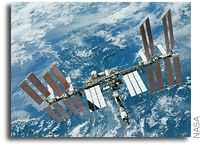NASA International Space Station Research Highlights Nov. 29 2010

Scott Kelly completed his 30th Psychomotor Vigilance Self Test (Reaction Self Test) run, out of 115 runs. The experiment is a portable five-minute reaction-time task that allows crew members to monitor the daily effects of fatigue on performance while aboard the station.
Six of seven test runs have been completed with the Synchronized Position Hold, Engage, Reorient, Experimental Satellites (SPHERES) investigation. The objective of this session was to run satellites with modified code in preparation for the Zero Robotics Session scheduled for Dec 14 and 15. The competition gives high school students an opportunity to design experiments for the station. As part of the competition, students write algorithms for the SPHERES satellites to accomplish tasks relevant to future space missions. The algorithms are tested by the SPHERES team and the best designs are selected for the competition to operate the SPHERES satellites aboard the station.
The Hyperspectral Imager for the Coastal Ocean (HICO) and Remote Atmospheric and Ionospheric Detection System (RAIDS) Experiment Payload (HREP) is operating nominally, with 2,127 images taken to date, including recent images of the Bahamas, the California coast and Chesapeake Bay. The objective of HREP is to launch and operate a rapid-development, cost-constrained visible and near-infrared imaging system to demonstrate the detection, identification and quantification of coastlines and terrestrial geophysical features. The experiment analyzes the water clarity, chlorophyll content, water depth and ocean or sea floor composition for naval purposes.
The JAXA-sponsored Chaos, Turbulence and its Transition Process in Marangoni Convection (Marangoni) has completed 17 of 24 runs. This physics experiment analyzes the behavior of a surface-tension-driven flow in microgravity.








